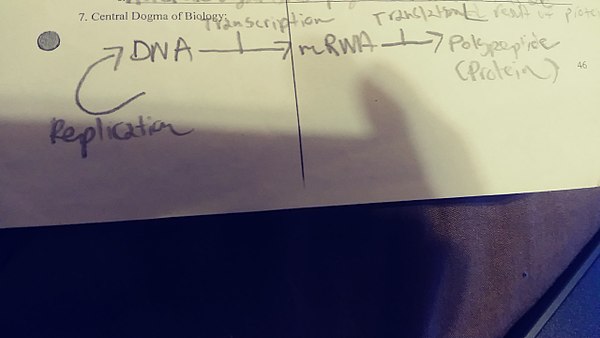RNA
 From Wikiversity - Reading time: 2 min
From Wikiversity - Reading time: 2 min


RNA is an essential nucleic acid in a body's coding. RNA has three types:
- mRNA - Messenger RNA, carries copies of DNA's instructions.
- tRNA - Transfer RNA, transfers amino acids in the cytoplasm to the ribsosomes for protein synthesis.
- rRNA - Ribosomal RNA, found in the ribosomes where proteins are assembled.
RNA's structure is similar to DNA, but RNA has only one strand while DNA is in a double helix structure.
| DNA | RNA | |
|---|---|---|
| Number of Strands and Shape | Double helix | Single helix |
| Nitrogen Bases | T, A, C, G | U, A, C, G |
| Sugar | Deoxyribose | Ribose |
| Phosphate group present? | Yes | Yes |
Transcription
[edit | edit source]
- What is transcription? The process of creating messenger RNA (mRNA) from DNA. The mRNA will then act as a script for creating proteins.
- What is RNA polymerase? An enzyme that is responsible for creating a mRNA by using DNA as a template.
- Step 1: RNA polymerase binds and separates DNA for a specific gene, which then codes for a specific protein.
- Step 2: One strand of DNA is used as a template to make mRNA. Termination point on the gene signals RNA polymerase to stop.
Introns and Exons both have different roles during transcription. Introns are cut out of mRNA sequence while exons are kept and bonded together to form a complete mRNA strand.
- Base pairing rules
| DNA | DNA | RNA | RNA |
|---|---|---|---|
| A | T | A | U |
| T | A | U | A |
| G | C | G | C |
| C | G | C | G |
Central Dogma of Biology
[edit | edit source]
Translation
[edit | edit source]
Recall: The monomers for proteins are amino acids.
mRNA uses codons, which are every 3 bases on the mRNA strand (code for an amino acid), to create proteins. tRNA are made up of amino acids and anticodons. An anticodon is a set of 3 bases on the tRNA molecule that will match an mRNA codon. tRNA is the opposite of mRNA.
Translation - Final step to creating proteins from mRNA.
- Step 1 - Initiation: A ribosome attaches to the mRNA strand. tRNA sees start codon, AUG, on mRNA molecule and begins translation.
- Step 2 - Elongation: Each mRNA codon is "translated" for an amino acid. tRNA carries in the amino acids and the polypeptide chain (protein) continues to grow.
- Step 3 - Termination: Translation ends when tRNA sees a stop codon on the mRNA molecule; Polypeptide chain is released.

Overview
[edit | edit source]
See also
[edit | edit source]| Look up RNA in Wiktionary, the free dictionary. |
Wikimedia Commons has media related to RNA.
Licensed under CC BY-SA 3.0 | Source: https://en.wikiversity.org/wiki/RNA20 views | ↧ Download this article as ZWI file
 KSF
KSF